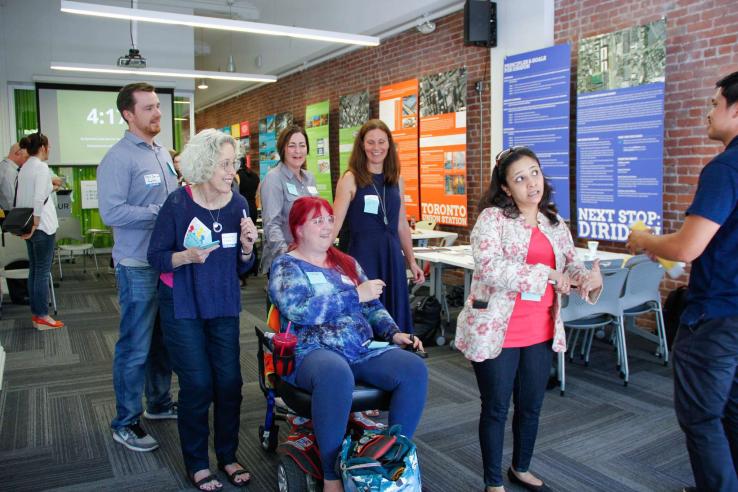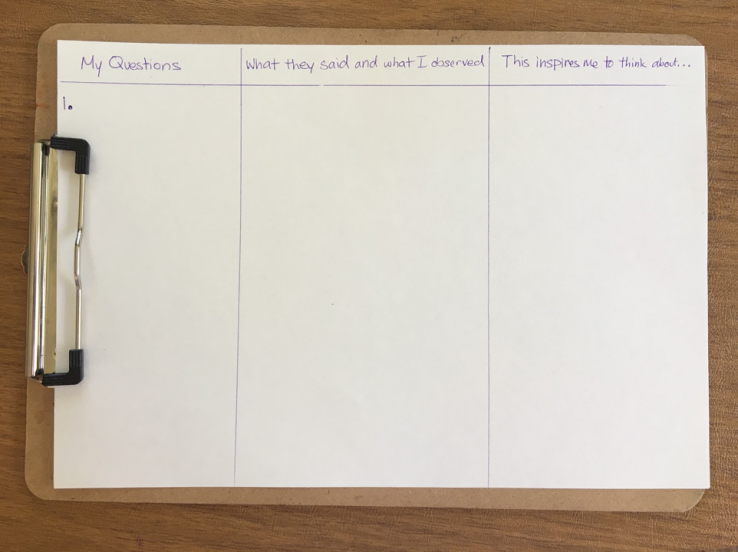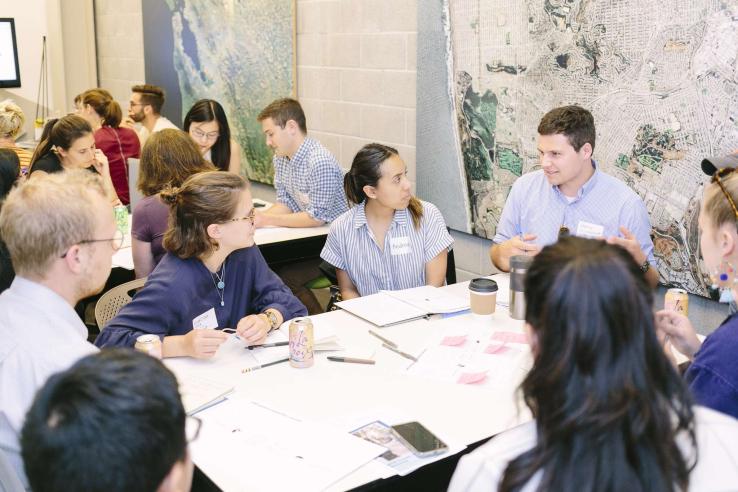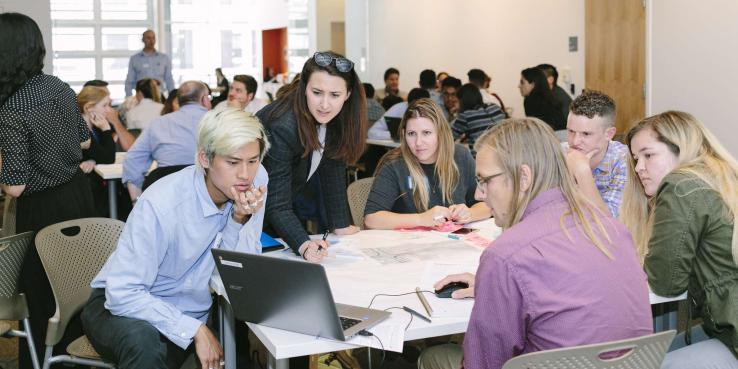The transportation experience in the Bay Area is marked by gaps that make it challenging for riders to use the many services available: gaps in service, gaps in information, gaps between how the transit network functions today and how it could be. What will it take to “mind the gaps” and bring the region closer to a truly seamless transit network?
At this year’s Transit + Design Workshops, sponsored by TransitCenter and hosted at SPUR’s San Francisco and San Jose offices, the sessions focused on research and design tools that transit planners and enthusiasts can use to “mind” or fill in the gaps that detract from a great customer experience. Solving these problems requires a willingness to try new approaches, experiment and iterate. It necessitates getting out of the building and talking to current and potential riders to unearth their needs, wants and expectations. And it often entails temporarily mending the gaps, as some are larger than others and will take a long time to truly fill in.
Here are seven tools for making transit a little more “gap-free.”
1. Mind the pain-point gap with “bodystorming.”
This year we partnered with Vinita Israni from Greenfield Labs to host a Transit + Design Workshop in San Jose for the first time. Using Diridon Station as our case study, the workshop focused on how to take a “user-centered” approach to station design. Israni taught participants how to conduct user interviews and observations to uncover riders’ pain points — what isn’t working for them — and positive points — what is working. From there, she led participants in synthesizing and organizing their learnings and come up with “provotypes,” preliminary solutions designed to provoke a response. But instead of asking the participants to talk about their ideas, Israni had them used their bodies — via role playing and charades — to bring the ideas to life, a process known as “bodystorming.” Bodystorming may not be for everyone, but as Israni explained, it can help generate unexpected ideas that might not be realized by talking or sketching.

2. Mind the vision and hearing gap with tactical design and hearing loops.
Brooke DuBose and Kristen Lohse from Toole Design Group led a workshop on how to make innovative street designs such as protected bike lanes and bus stop extensions work for people with vision disabilities. These features make it safer to bike, walk and take transit, but they can be challenging to navigate for those who rely on predictability and linear arrangement of features like streetlights and tactile paving to navigate the street.
Drawing from a report that Toole Design Group authored for the Federal Highways Administration, DuBose and Lohse explained that new kinds of streets must be introduced with consistent design qualities to reduce confusion. One tactic they used to identify these designs was to develop a tactile street mockup that could be felt and touched.
Carl Orman, the Accessibility Program Manager at BART, spoke to what BART is doing to make it easier for people with hearing disabilities to pick up audible messages in transit stations. BART has started installing hearing loops devices — thin wires that transfer audio signals into a magnetic field that emits a signal anyone with a t-coil enabled hearing aid can pick up. Hearing loops block out background noise from passing trains, cars and wind and allow for the clear, direct transmission of information.
3. Mind the stakeholder gap with collaboration.
Judi Brown and Leah Tremblay-Adams from CivicMakers asked participants to think critically about community engagement: How engaging is it, really? Who from the community is included and who is left out of the process? During their session, they introduced an approach they call “human-centered community engagement,” which posits that community engagement should be designed with, not for, the end user through collaborative problem solving and creative experimentation.
CivicMakers shared their stakeholder identification exercise, which prioritizes those who have direct, lived experience with the particular challenge, product or service to be developed. Workshop participants identified a list of stakeholders and began to construct their own engagement plan while identifying any gaps in consultation with other attendees.
Brown and Temblay-Adams explained that the engagement plan should focus on building public ownership and trust, fostering inclusivity by meeting people where they are and placing those who are most vulnerable or hardest to reach at the center. They recommend lowering the barriers to participation by providing childcare, offering online access or joining existing community gatherings.
4. Mind the interview gap with the “five whys.”
Talking to riders — and non-riders — is a great way to gather insights about what’s working with transit, what’s not working and why. But where to begin? In their workshop, human-centered design coach Amanda Damewood and user experience designer Lisa Ratner offered a deep dive into the nuts and bolts of user interviews. The key lesson? Prepping is essential. Don’t just go out and talk to strangers; prepare questions beforehand. They suggested avoiding questions that already assume an answer, like “Tell me how the number of transfers influences your transportation decisions” and to instead use open-ended questions framed positively, like “Tell me about the last time you used transit.” From there they suggest gradually asking for more specific answers.
Damewood and Ratner also recommended a tactic known as the five whys: asking “why” five times after an answer. While this may feel like something only a 4-year-old should do, it gives people time, space and permission to go deep. Asking “why” helps get to the core reasons or beliefs that causes people to make the decisions they do, instead of just describing their actions.

5. Mind the street-design gap with Remix for Street Design.
A team from Remix and the Santa Clara Valley Transportation Authority led a workshop on designing streets for the modern, multimodal city. They challenged their workshop participants to think about what better streets could look like, who they could be designed for and how streets could prioritize the different ways people move. They introduced a new product, Remix for Street Design, which offers a way to test different street layouts and visualize data.
The presenters organized the room into teams and asked each team to brainstorm how they would improve the safety and comfort for all users on King Road, a collision-heavy Vision Zero corridor in San Jose. Participants used Remix to do things like narrow traffic lanes, widen walkways, add protected bike lanes, bus boarding islands and transit-only lanes, and reduce the space dedicated to parking. The workshop highlighted the benefits of integrating different data sources into a single platform, while emphasizing the value of taking an iterative approach and working toward solutions.
6. Mind the customer-needs gap with the Value Proposition Canvas.
What is a rider’s “job to be done”? This phrase may sound odd, but as Maarten van Lieshout from Business Models Inc. explained, it’s exactly how transit planners should be thinking about their riders. Riders aren’t buying a ride on transit; they’re hiring transit to fulfill a job. That job can be functional, like getting them to work, social or emotional, like helping them spend time with friends, or values-driven, like helping them be environmentally friendly.
In the workshop, van Lieshout discussed the Value Proposition Canvas, a tool that can help ensure that a product or service is designed around what the customer actually values and needs. The canvas consists of two building blocks — a customer profile and a company’s value proposition — and is used to analyze the “fit” between them. Does the value proposition match the customer’s job-to-be-done, or is the product leaving the customer behind?
Maarten teamed up with staff from Oakland’s Department of Transportation to demonstrate how the canvas works. To start, identify who the customer is and detail their job-to-be-done. Next, identify the gains: What would make the customer happy? What would make their job-to-be-done easier or better? Then identify the pains: What is annoying customers? What is preventing them from getting their job done? The second part of the canvas, the company’s value proposition, starts with identifying the products or services that could potentially address the job-to-be-done. A fit is achieved — often after many iterations of design and development — when the products and services address the most significant pains and gains from the customer profile.

7. Mind the ideation gap with a focus on the extremes.
Coming up with new ideas can seem like a monumental task. But as Ximena Sarango from the San Francisco Mayor’s Office of Civic Innovation and Carrie Bishop with the City of San Francisco’s Digital Services Office explained, it requires an understanding of the problem, a willingness to be imaginative and practical, and a commitment to iterating. One technique they taught was to use extremes, setting an absolute best scenario against an absolute worst. While the most functional design is not always the most drastic, they explained, using extremes can help inspire solutions to a problem.
Workshop participants applied the ideation techniques to a transportation challenge facing San Francisco, provided by Warren Logan from the San Francisco County Transportation Authority and Danielle Harris from the San Francisco Municipal Transportation Agency. Working in small groups, they brainstormed ways transit could be redesigned to better meet the needs of single parents working nightshifts, busy retirees and extracurricular-bound teens. They perfected their ideas by assessing what a “worst” and “best” idea would look like for each of the personas.
Conclusion
Whether minding or mending gaps, the tools and research approaches these workshops presented amount to a new way of approaching transportation planning. And that’s a good thing. We need new tools to better understand what riders need and want from their transit experience. Only then can we start to transform the way people perceive and use public transportation. The more we recognize and address the impact transit gaps have on the rider experience, the more Bay Area transit operators will be able to offer people an enjoyable, attractive and “gap-free” transportation experience.
